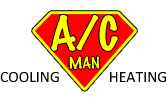Do Air Conditioners Need To Be Covered During The Winter?
Your residential HVAC system requires maintenance periodically throughout the year. When fall turns into winter, it is then the ideal time to get your Houston AC ready for the weather that lies ahead. Later in the year, as the hot days of summer transition into the cooler days of fall, it is time to shift your focus to your furnace or heating system. One question that many people ask AC Man Of Houston is whether their air conditioner needs to be covered when it is not in use during the winter season or to protect it from bad weather.
Covers Provide Protection Against Outside Elements
A lot of times, people mistakenly believe that they need to cover their air conditioner during the winter months. In fact, it is far more important to cover the outdoor Houston AC during the autumn season. This is the time of year when leaves, seeds, and other small bits of debris are falling from the trees. If these items become caught in your Houston AC unit, they can trap moisture, which can eventually cause the surface to corrode. Accumulated piles of leaves may also interfere with your air conditioning unit’s ability to drain. At the same time, you need to use caution when covering your Houston AC. Avoid covering the entire Houston AC unit. Instead, purchase a cover that extends approximately half a foot down each side of the unit. Make sure that at least a portion of the unit is exposed to the air to keep moisture from becoming trapped underneath the cover. Any moisture or condensation that can’t escape could lead to rusting or corrosion.
Protect Your Houston AC From Bad Weather
One common misconception that people have is that air conditioners need to be carefully protected from the weather. This probably stems from the fact that many summertime accessories have to be stored away during the winter. For instance, lawn chairs, patio tables, and other types of outdoor furniture are usually covered or kept indoors during the winter to keep them from getting damaged. Most Houston AC systems are tough enough, however, that they don’t need to be covered. Below are some of the primary reasons why people cover their units along with additional information on whether or not a cover is actually necessary.
1. Dirt In The AC
As your air conditioner operates, it draws in air from the surrounding area. Sometimes, it also draws in the dirt along with that air. After the unit is turned off, however, dirt is extremely unlikely to get inside, meaning that you shouldn’t need to cover it when it is not in use.
2. Ice Or Snow In Your AC
The companies that manufacture air conditioners design them to be strong enough to withstand extreme conditions during the winter months. Typically, a cover is not required to protect your unit from the weather.
3. AC Water Damage
Any type of moisture can cause damage to your air conditioner over time. Unfortunately, moisture is something that is impossible to prevent. This is especially true if you live in a humid environment. Even if your unit is covered, moisture can still get in. Covering your unit can make the situation even worse, however, since a cover can keep moisture trapped inside your Houston AC, preventing it from escaping. This can lead to problems with mold, rust, and corrosion. To avoid this problem, most experts recommend not using a cover.
4. Small Creatures
Critters like rodents tend to be drawn to places that are covered and protected when the weather changes. In this case, leaving your unit uncovered may help discourage these animals from taking up residence inside your Houston AC.
To Cover Or Not To Cover?
If you own an air conditioner, it is important to know when it should be covered and when it should be left uncovered. As a general rule of thumb, the only time that you should cover your unit is during the autumn when leaves are falling off of the trees. Make sure to choose a cover that fits the unit correctly. During the rest of the year, you should be able to leave your unit uncovered without worrying about it sustaining any damage.
For more information on Houston AC systems, contact us today by giving us a call at (713) 460-2653. If you would like to read more related content be sure to check out our blog!
